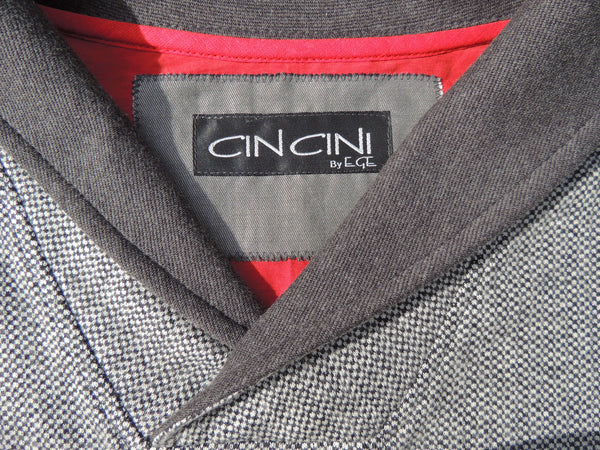

Sew-along with us!
Perhaps you'd like some company while you sew? We've sewn up each of our patterns and photographed each step along the way. Find the pattern you're after in the filter drop down below left.
Sew-Alongs
Finlayson Sweater Sew-Along: Day 7 - Finishing the cuffs and hem band
Can you believe it? Today we'll be adding our cuffs and hem band...and finishing the day with a cozy sweater to wear!

You may have noticed that we included two Cuff pattern pieces - I probably should have mentioned this second cuff piece when we cut our Finlaysons out of fabric early on in the sew-along. But, alas, I forgot to! So we'll discuss it now: We included the second, larger, cuff piece for you to use based on the extremely helpful advice of our test sewers. You may have noticed that I am adamant about the versatility of the Finlayson Sweater pattern when it comes to fabric choices. One of our test sewers noted that fleece fabrics (a great choice for a cozy sweater!) REALLY vary in the amount of stretch they contain. So that you won't be constrained in your choice of fleeces (as long as they have a little bit of stretch), we created the Optional Cuff for you to use. Cut your cuffs from this piece so that you won't have to ease so drastically when attaching the cuff to the larger sleeve...much easier to sew if you don't have much stretch to work with!
With that in mind, onward with our sewing of the cuffs! Whether you use the main Cuff pattern piece of the Optional Cuff piece, the sewing process is essentially the same:

Fold your cuffs in half to match notches together. Pin along the notched edge (in the photo above, the fold is on the left hand side).

Sew along this notched seam. I used the reinforced stretch stitch as per with the rest of the sewing process for my Variation One sweater.

If using a stitch that allows you to open the seam, press your seam open. Otherwise, you can simply press the seam to one side.

Now fold the cuff in half (so that you are folding the seam that you just sewed in half). Press along the fold - this will be the very bottom of the sleeve.

Stretch the looped cuff over the sleeve end so that all three raw edges line up (I've shifted the cuff up the sleeve in this photo so that you can see all the layers clearly).

Pin the cuff in place - be sure to line up the seams and stretch the cuff evenly around the sleeve.

In the photo above you can see how much easing you will need to do! (Now you can see why it is far easier to use the Optional Cuff piece if your fabric doesn't stretch much!).

I really like to apply clear swimsuit elastic to the cuff seam because I often push my sleeves up my elbow and can't stand when my sleeves stretch out and slip downwards over and over again throughout the day. This clear bit of elastic will do wonders to prevent stretching! I have often read that you shouldn't allow your needle to punch directly into clear swimsuit elastic as you risk creating a weak point where it will snap. I have never had this problem yet, but please keep this in mind and consider using a stitch that will capture the elastic by encasing it in stitching (a super wide zig zag or serging, for example). I just used a narrow zig zag stitch!

If your fabric is loosely knit (mine isn't!) you might consider pulling the elastic slightly as you so to give more structure to the seam and fully prevent any fear of stretching out.

Once sewn, trim your seam allowances and press them towards the sleeve (away from the cuff).

To sew the hem band, simply repeat the process that we used for the cuffs - you won't have to ease quite so much with this pattern piece though! Once you've formed a loop with the hem band, pressed the seam open and pressed the band in half length-wise, encase the sweater with the hem band and line up all three raw edges. Line up one of the side seams with the hem band seam.
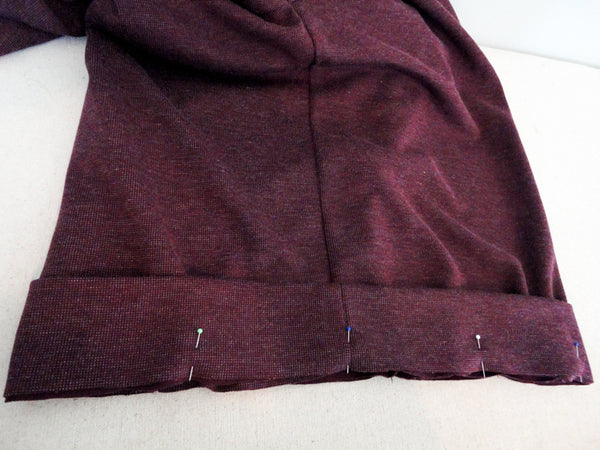

I stitched my hem band using a reinforced stretch stitch and finished the seam allowance with a wide zig zag stitch.

Trim your seam allowance, if desired...

...and press the seam allowances up towards the sweater.

And we're done! If you were sewing Variation One, you are done your sweater! Congratulations!!!

Now, onwards to Variation Two. As with the previous sew-along post, the sewing process for the cuffs and hem band are the same as with Variation One. Begin by pinning the cuffs and hem band in half (matching notches).

I serged this variation but use your preferred stitching method of choice to finish the notched seams.

Press the seam open or to the side (depending on your stitch type) and then fold the cuffs and hems in half width-wise.

Press the hems and cuffs to create a crisp fold (which will be the bottom of the sleeves and the bottom of the sweater.

Pin the cuffs and hem band over the sleeves and sweater, matching all three raw edges.

Sew these seams - I sewed them with my serger. In case you are interested to know: My serger has trouble cutting through several medium-weight knit layers - especially when I have to cross over the extra layer of the kangaroo pocket or the sleeve and side seams - to combat this issue, I often trim my seam allowances with scissors before sewing so that only 1/4" of the allowance remains. That way, I don't need to cut off any fabric with the serger blade while sewing! Trimming first works a treat :).
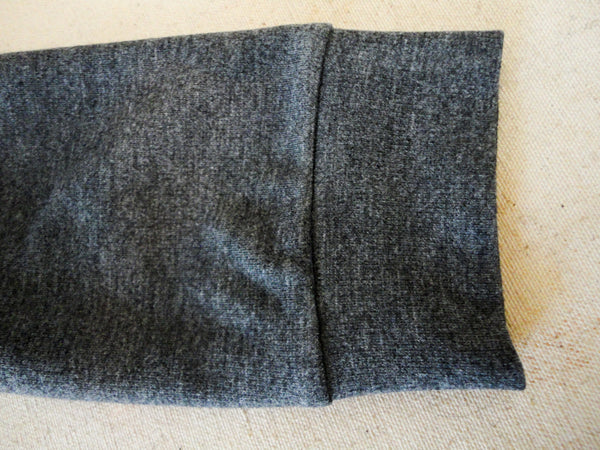
And we're done Variation Two! Congratulations on sewing such a cozy and well made sweater.
Finlayson Sweater Sew-Along: Day 8 - The Parade
Today I am really excited to announce the winners of our Finlayson Sew-Along Contest! Thank you to everyone who busily sewed and submitted their entries.
Let me tell you, it was a super tough decision to choose these winners! But, we managed to whittle the choices down and, without further ado, here they are!
The winner of the Canadian Entry Prize: $30 Gift Certificate to Simplifi is Natasha for her innovative use of shoe laces!
Natasha used a printed shoe lace instead of twill tape to finish the neck seamline and the raw edges of her kangaroo pocket.
I think the result looks really professional and goes with her fabric choices perfectly (organic cotton sweater fleece and corduroy cut from a pair of old pants). I've seen all sorts of interesting printed and coloured shoe laces at department stores, shoe stores and even skate shops so I think it would be far easier to find a nice printed cotton shoe lace for your Finlayson Sweater than the same quality printed cotton twill tape (judging by what is available at my local fabric stores). Thanks for the great idea Natasha!
The winner of the Third Prize: A $30 Gift Certificate to Girl Charlee is Tina Wheeze for her awesome alpine sweater!

The contrast sleeves are a great way to make such a bright print less overwhelming and I really like how she used the print for the cuffs.

Second Prize: $50 gift certificate for Britex Fabrics, goes to Jackie for her Star-Wars themed Finlayson.
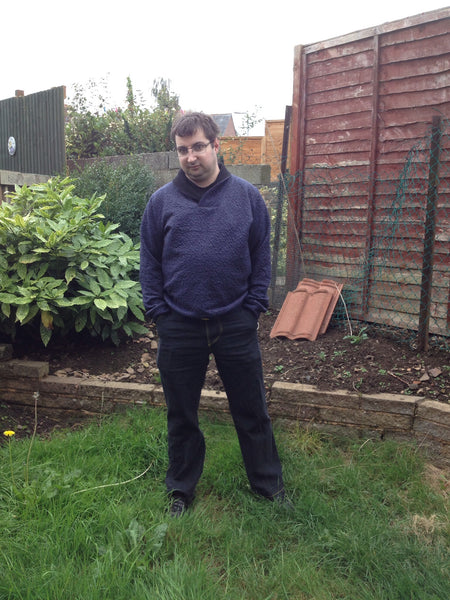
The contrast collar looks lovely paired with the textured blue knit. And I really like how she used both the twill tape and facing to completely personalize the sweater.

PLUS, I love the effort and humor that went into Jackie's Star Wars comic!

And, drum roll please! First Prize is a $100 shopping spree at Hart's Fabric and this awesome gift certificate goes to Ann Kin for her impeccably sewn Finlayson Sweater. The fabric choice is so classy, the fit is spot on and the contrast collar is such a nice detail.
Most impressive, though, is Ann's careful stitching. Just look at THAT:
Congratulations to all of the winners and a huge THANK YOU to all the participants of our Finlayson Sweater Contest!
Eastwood Pajamas Sew-Along : Day 1 - Choose a size and variation
Eastwood Pajamas Sew-Along Schedule
Day 1: Elastic choices, adjusting for fit and style
Day 2: Cutting out fabric, sewing the optional patch pocket
Day 3: Sewing the inseams and optional mock or functioning button fly
Day 4: Pockets and side seams
Day 5: Waistband, optional drawstring and hemming
Finished - the PJ Parade
Let's start work on our Eastwood Pajamas! Today we will be discussing elastic choices as well as modifications you can make for fit and style.
Picking a Variation
First thing first, we need to pick the variation we want to sew. I've broken the pattern into three paths:

#1: Quick with few details: These are the simple drawstring pajamas that are an ideal batch sew for all the men in your family at Christmas or an excellent first time garment for a sewing instructor to walk their student through. They feature an encased elastic waist (simply fold over the fabric, stitch and then insert the elastic), inseam pockets and no extra topstitching. They do not have any sort of fly.

#2: A moderate amount of details: Try this variation if you want to practice your topstitching, love the look of a fly without quite so much effort (they feature a simple mock fly), and want a functional drawstring. They feature topstitching along the seat seam for added strength.
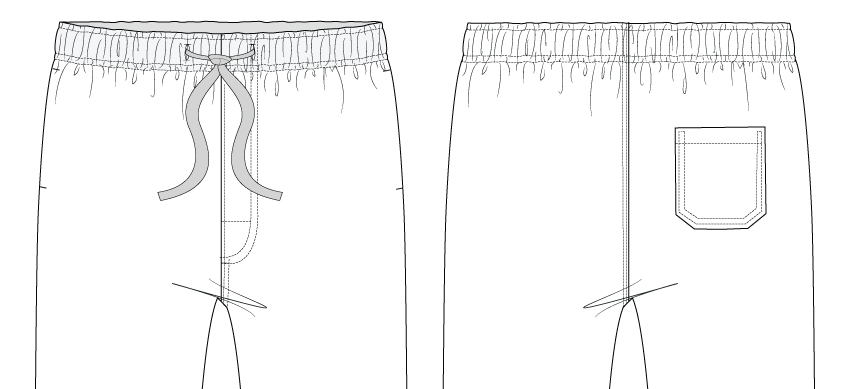
#3: All the bells and whistles: A great practice run before sewing your first pair of jeans! Add a patch pocket (just as you would for jeans), create a fully functioning button fly and then sew all the detailed topstitching included in Variation 2.
Of course, there is nothing stopping you from mix and matching - for instance, you could topstitch the seat seam on Variation 1, add a patch pocket to Variation 2, or skip the drawstring on Variation 3. Let your patience, skill level, and fabric choice help you to decide how many details you would like to add or avoid.
Choosing Your Size

Before you choose your size for the Eastwood Pajamas, please read over the "How to Choose Your Size" section on page 3 of the instruction booklet. You'll notice that I recommend choosing your size based on the man's hip circumference. This is because the waistband size can quite readily change depending on the elastic style that you choose and how you fit the elastic to the wearer. This makes it very easy to pick a size that you know will fit well - as long as there is enough ease (room for movement) in the hips, you have plenty of wiggle room for adjustments at the waist and legs!
All About Elastic

To find the correct elastic length, refer to the Elastic Requirement Chart (below and on page 4 of the instruction booklet), but, unless your pajamas are a surprise gift, please don't stop there!
 Wrap the recommended amount of elastic around the man where he would like the pajamas to sit. People differ greatly on how they like their pjs to sit - they may prefer to sit them up higher on their waist for a close fit at the crotch or, as is more common, they may sit them quite low for an easy fitting crotch (and some people sit them so low they almost look like a dropped crotch!). One pajama pant design can be worn in many different ways...thus, you will ensure the best fit if you circle the elastic around the wearer where they like it to sit and circle it as snug as they find comfortable.
Wrap the recommended amount of elastic around the man where he would like the pajamas to sit. People differ greatly on how they like their pjs to sit - they may prefer to sit them up higher on their waist for a close fit at the crotch or, as is more common, they may sit them quite low for an easy fitting crotch (and some people sit them so low they almost look like a dropped crotch!). One pajama pant design can be worn in many different ways...thus, you will ensure the best fit if you circle the elastic around the wearer where they like it to sit and circle it as snug as they find comfortable.
Elastic varies greatly and may stretch out as you stitch over it while topstitching to complete the waistband for Variation 2 and 3. You might like to take a scrap of elastic, fold it inside a scrap of fabric and then do some 'practice' topstitching over it. Do you notice the elastic stretching or does it retain it's shape. If it stretches longer and does not snap back once you've finished stitching, you'll likely want to choose a different, better quality elastic.
Here are some options I like for enclosed waistbands:

Top Choice: Woven Elastic - this is a tough elastic that is not prone to rolling. It does not become narrower when stretched and does not weaken when sewn through. Most woven elastics are intended to be sewn into casings so they are not very soft. They pair best with mid to heavy weight materials since they are so thick - a woven elastic like the one pictured would be perfect for cotton flannel pjs. The image above is from an excellent post by Craftsy explaining different types of elastics and their uses...check it out for more info!

Runner Up: Knitted Elastic - a good quality knitted elastic is both soft and strong. It retains it's width when stretched and (if it is good quality) it retains it's strength when stitched through. Test a knitted elastic carefully before committing to using it (by stitching through it as mentioned above) to see if it ripples and becomes mishap-pen. The above photo is the sturdy knit elastic that we used to stock in our shop to pair with our Comox Trunks. You can find something similar here.

Avoid: Braided Elastic - This type of elastic loses it's stretch when it is stitched through so it is not a good choice for Variation 2 or 3 of the Eastwood Pajamas. You could get away with using it inside the casing of Variation 1 but a better choice would be woven elastic which would be far less likely to roll within your casing. Braided elastic lovely in narrower casings (elasticated sleeve hems or lingerie for instance) so, let's save it in our stash for that purpose!
Adjusting Leg Length
After determining the correct size based on the hip measurement and determining the elastic length and desired fit at the waist, it's time to check leg length. You can adjust the length of the Eastwood legs for both fit and style preferences.
Lengthening or Shortening for a full length pajama:

Before cutting out your fabric, be sure to measure the man's inseam. You can either measure on their body or, more accurately, you can grab a pair of the man's favorite pjs or trousers and measure those. This is more accurate because then you will be able to determine how low he prefers the crotch of his pants to sit (instead of measuring right up to the top of his leg). If the inseam on the Eastwood Pajamas differs from his preferred length, don't worry, this is an easy adjustment. Use the "Lengthen and Shorten Here" line and the tutorial on our website to adjust the pattern to his perfect length.
Shortening to create cropped pajamas:

There are a few ways you could go about making breezy cropped linen pjs. The simplest is to just roll up the hem of the finished pjs to create a cuff (as per the example above from our Eastwood Pajamas Pinterest board). You could tack this in place by stitching along the inseam and side seam so that it doesn't come unrolled. Or, if you don't want the bulk of a cuff, you could shorten the PJS as per our tutorial but this time, overlap until you reach your desired inseam length. I think 4-6" should do it! Once you overlap you'll need to smooth out the lines to create a nice taper but you won't need to do anything more than this since you've preserved the hem shaping! Now, just sew as per the instructions.
Shortening to create boxers:

To create boxer length Eastwoods, you will need to draw a new hemline. Measure the inseam of the man's preferred boxers...it will likely be somewhere between 3-6" (the example above looks close to 6" to me). Draw a horizontal line across the front and back pattern pieces, just like the "Lengthen or Shorten Here" line. Don't cut here though! We need to add the hem. This needs to flare out to match the taper of the side and inseam. I've detailed how to do this in the Sayward Raglan Sew-Along. In that scenario we were shortening a sleeve pattern piece but the exact same steps apply! For the Eastwood Pajamas you will need to add a 1.5" hem (whereas the Sayward featured a smaller 1" hem).
Eastwood Pajamas Sew-Along: Day 2 - Cut into your fabric
Let's cut into our fabric today! Exciting!

If you are sewing with a fabric that doesn't include a directional print, you might like to try your hand at rearranging the cutting layout to save a bit of fabric. For example, I flipped one of my leg pieces upside down and was able to cut out a size XL using 1.9 m instead of 2.4 m. Your fabric use is very dependant on the size you are sewing too, this is why we broke the Materials Required chart and Cutting Layouts into two separate size groups. You will use a lot more fabric for a size 4XL than you will a XS and you likely won't be able to save fabric by flipping a pant leg when sewing anything much larger than an XL due to the width of the pant legs in proportion to the fabric.

Remember, when cutting out your pieces, to measure from the grainline to the selvage or fold of the fabric at the top and bottom of each piece (as pictured above). This will ensure that you have the pieces precisely on grain which is especially important for long pieces such as pant legs. If you are sewing with a plaid, you might like to pay attention to plaid matching or avoid it as much as possible by placing the patch pocket on the bias. I decided to match the plaid on my patch pocket but I never do a very good job of this...plaid matching is not my strong suit! If you look at many store bought plaid pajamas closely you will notice that plaids are rarely matched...if you enjoy plaid matching and feel that this will elevate your finished garment above what you might find in the store, go for it! If you detest plaid matching (like me), don't beat yourself up about it and just focus on tidy topstitching and personalised details to wind up with a lovingly sewn pair of PJs!
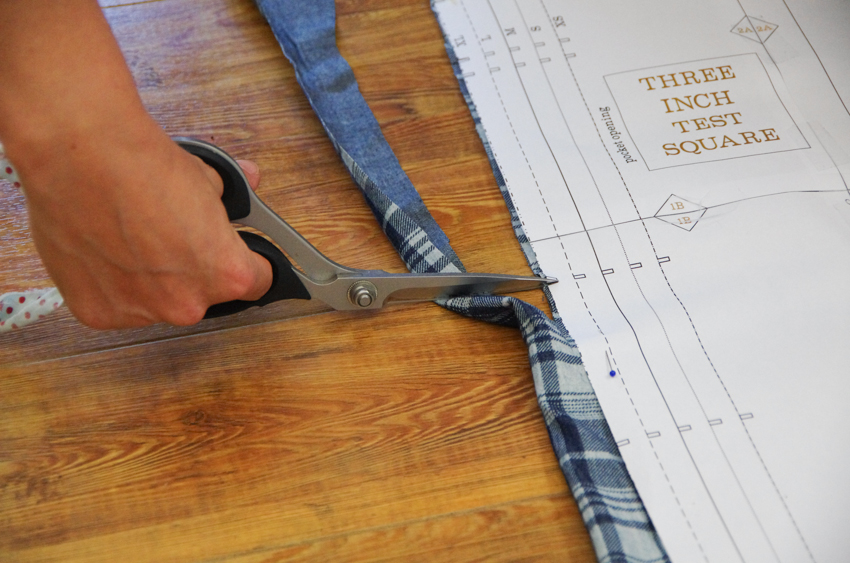
Be sure to clip into each notch as you cut out your pieces. If you desire, you can mark them by cutting small triangles outwards or by marking with chalk but these measures are not necessary with this sewing project because the seam allowances are so large and we won't be needing them uncut for things like french or flat fell seams! Simply clipping 1/4" into the seam allowance is certainly the fastest and perhaps most accurate way to mark notches.
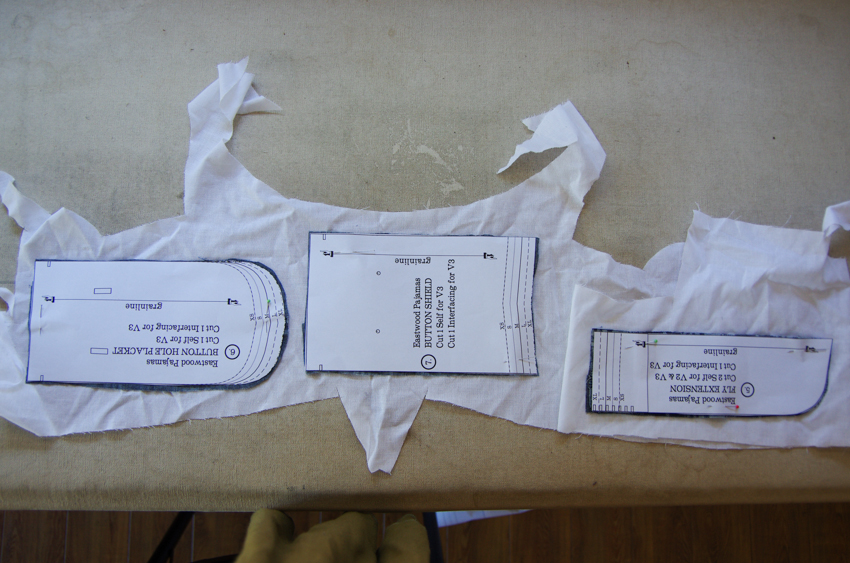
If you are sewing variation 2 or 3 (I'm sewing variation 3), you'll need to cut pieces 5, 6, and 7 from interfacing. Hopefully you can use a small scrap from a previous project rather than having to buy more interfacing...these PJs use such as small amount!
Now that our pieces are cut out, you can choose to transfer the pocket placement marking now or I will show you a quick way to place your pocket a in a bit...just keep your Back pattern piece handy (piece 2).

To assemble our pocket we first need to finish the top edge. You can get fancy by making some binding from one of your fabric scraps if you like. The binding does not need to be on the bias since it doesn't travel along any curves. Alternatives are serging across the top, using pinking shears or zig zag stitching.

Fold the top edge along the notched fold line with right sides together. Stitch this fold in place with a 5/8" seam allowance on each side.

Trim the extra seam allowance away to reduce bulk and then flip the pocket top right side out. Use a point turner, knitting needle or chopstick to poke out the corners until they are crisp. Press.

Fold under the rest of the seam allowances and press. If you would like to reduce bulk and hide the raw edges within the topstitching we will perform later, you can trim your seam allowances to 3/8" or even smaller as pictured below.

Ensure that your pocket looks nice from the right side (no bumps along the sides), and then topstitch the top edge in place at 1/2". I always forget this step until I've begun to attach my pocket to my pant leg...don't forget this like I do!

Okay, now we are ready to attach the finished pocket to the right leg (if you were wearing the pants). Lay your pant leg on your work surface. The right side should be facing you and the curved crotch should be pointed towards the left...if you double check that this is the case you will be certain that you grabbed the correct leg!

To quickly place the pocket on the pant leg, lay the pocket approximately where you think it might go. Next, lay the paper pattern piece upside down on the pant leg and pocket so that the curved crotch of the paper and fabric line up. Fold back the paper pattern piece crisply along the top pocket placement dots:


Now shift the pocket up or down until the top edge matches this paper fold. Your pocket is now placed! Remove the paper pattern and pin the pocket to the pant leg.

Edgestitch the pocket in place and then continue your stitching to topstitch 1/4" away from the edgestitching to make a very strong pocket.

Stand back and admire your pocket! I'm pretty happy with my plaid matching in this case (it's not perfect but darn close!).

We will continue with the sewing process on Wednesday...be sure to give yourself a good long chunk of sewing time if you are stitching Variation 3 as we will be constructing the entire fly. If you are sewing Variation 1 you won't need nearly as long. I won't be walking through Variation 2 but will point you in the direction of some great mock fly tutorials if you need some extra help!
Eastwood Pajamas Sew-Along: Day 3 - Inseams and fly
With our fabric cut and patch pockets added we are ready to move on to the inseams today. No matter the variation you are sewing, proceed by place one pajama front and one pajama back with right sides together. Pin along the entire inseam.

Stitch the seam using a 5/8" seam allowance and press open. You can finish the seam allowance in whatever method you have available to you - pinking shears, zig zag stitch or a serger as I have done. Repeat this process with the second pajama leg.

Now that the inseams are sewn, our paths diverge depending on what variation you have chosen. If you are sewing Variation 1 (with no fly), simply place one of your pajama legs on your work surface with right sides up.

Add the second leg on top so that right sides are facing. Pin the two layers together along the entire curve. Ensure that the inseams are matching.
Stitch using a 5/8" seam allowance along the entire curve. Optionally, you can add strength to the crotch by stitching the whole curve once more. Press the seam open along the front and back of the curve (you won't be able to press open the crotch area since the curve is too steep, but that's ok, it is just the flat front and back that need pressing).
Variation 1's seat seam is now complete! I'm not going over Variation 2 during this sew-along (the mock fly), but you can have a look at this great tutorial by MellySews. The main difference with this tutorial is that their fly extensions are already attached to the pants front...we just need to sew ours on first.
Now, let's delve into the button fly included within Variation 3. To prepare for sewing the fly, we first need to attach the fly extension to the left pajama front (if you were wearing the pants). Before attaching it, finish the curved edge of the extension in your preferred manner (pinking, zig zag or serger).

Now place it on the pants front with right sides together and line up the bottom with the fly placement notch.

Stitch the extension in place using a 5/8" seam allowance.

Now finish the seam allowance using your preferred method again. If you are serging or zig zag stitching, be sure to catch the fly extension seam allowance while you stitch.

Don't forget to finish the right leg seam allowance too!

Press the seam allowance towards the fly extension:

Now its time to sew the seat seam. Line up the two pant legs with right sides together. Be sure to align the inseams. Pin thoroughly. Begin stitching at center back with a 5/8" seam allowance and stitch around to the bottom of the fly extension. Backstitch and then switch to a long basting stitch for the entire length of the extension. Switch to a regular stitch length and backstitch before proceeding up to the waistband.

See how the stitching ignores the fly extension and continues up the seat seam?

Clip both seam allowance at the bottom and top of the fly extension to make it easier to press the seam allowances in the correct direction. Here are the bottom seam allowances clipped:

And the top seam allowances clipped:

Press the seam allowance and fly extension open. Press the rest of the seat seam (below the fly extension) towards the left leg (if you were wearing the pants).

Flip your pajamas to the right side and edgestitch 1/8" from the seam along the entire length of the seat seam. The stitching should only be on the left leg (so you are stitching to the right of the seam when you're looking at the right side of the pj front as pictured below).

With the seat seam finished, let's prepare the rest of the fly pieces now. Bring out your Buttonhole Placket and Button Shield pieces.
Fold the buttonhole placket (the one with the curved bottom) with wrong sides together and finish the curved edge in your preferred way (zig zag stitch or serging...pinking doesn't work in this case because we need to attach the two layers together).
Before proceeding to the button shield, don't forget to finish the placket by adding a buttonhole to suit the length of your chosen button! Place the buttonhole as per the marking on the pattern piece. As always, I forgot to add the buttonhole at this point, but don't worry, I'll show you that it is still possible (but a bit finicky) to add the buttonhole at the very end when your pajamas are fully constructed.

Create the button shield by folding the piece with right sides together. Stitch along the bottom angled edge with a small 1/4" seam allowance. Flip right side out and press. Finish the long raw edge by serging or zig zag stitching.

With our pieces ready, it's time to finish the fly! Begin by placing the PJ front on your work surface with the wrong side facing you. Lay the Buttonhole Placket on top of the fly extension so that the curved edge is aligned. The Buttonhole Placket will not quite reach center front...that's how it is supposed to be, don't worry! Pin the Placket in place through all layers.

With everything pinned in place, flip the pjs so you can see the right side. Lay the Fly Topstitching Template on the left front (if you were wearing the pjs). Place the bottom of the template 1/4" up from the bottom of the extension...you can do this by feeling for the bulk of the extension with your fingers.

Trace along the curved edge of the template with chalk or a pencil. Make sure your marking tool will easily wash off of the fabric! Continue the topstitching line all the way up to the waistband edge. I like to ensure I keep the same width from center front by moving my template up and continuing to trace it.

Topstitch along the marked line. Create another row of topstitching 1/4" closer to center front.

Now we'll add the button shield. This will be stitched to the right seam allowance only. Lay the PJs on your work surface with the wrong side facing you. In the instructions I show the front spread out but in the photo below I've shown them folded in half so only the right seam allowance is visible. This is to give you another perspective - either way that you lay out your PJs, what I'm trying to show is that you must only pin your shield to the seam allowance and not to the pants front.

Stitch the shield to the seam allowance using a 3/8" seam allowance.

From the right side of the PJs, remove the basting stitches along the fly. Careful not to go too far and remove your backstitching!

You'll notice, when you open your fly, that the right front (if you were wearing the pants) has a pressed pleat. By removing this we will offset the button shield so it is not visible when the PJs are worn.

To remove the pleat, pull the button shield flat (spread the pleat apart), and then press.
Keep the button shield in place by edgestitching 1/8" from the seam on the right pant leg. Extend your stitching as close as possible to the top and bottom of the fly.

The next thing you might notice is there is still a gaping hole at the bottom of your fly...that won't do! Close off the bottom (and secure the button shield from flapping about) by stitching a horizontal line 1.5" up from the bottom of the fly.

Next, create a second row of topstitching along the seat seam extending from the waistband at center back up to the horizontal line that you just added to the fly:

Finish securing the fly pieces in place by temporarily basting across the top edge of the fly. This will later be secured when the waistband is folded over.

And there we have it! A completed button fly with three tidily sewn layers - the lowest layer holds the button, the middle layer holds the button hole and the top layer nicely conceals it all.

If you like, you can stitch your button on at this point or you can wait to add it when I do as the very last stage of constructing the PJs.

Next we will be sewing the inseam pockets and side seams! See you then!
Eastwood Pajamas Sew-Along: Day 4 - Side seams and pockets
Today is an easy day in comparison to the functioning button fly... we are assembling nice deep inseam pockets and sewing up the side seams!

Begin by finishing the side seams in your preferred manner (pinking shears, serger, zig zag stitch...you could even get fancy by binding them if you like). I've serged mine.

Next, finish all edges of the four pocket bags. Again, I've serged mine but pinking or zig zag is perfectly acceptable!

Line up each pocket bag to the pocket markings on the front and back of the pajamas. Right sides are together. Pin along the side seam.

Stitch the pocket bag to the pajamas using a scant 5/8" seam allowance. We want this to be a little smaller than a full 5/8" seam allowance so that the stitching does not interfere with a future step.

Press the seam allowance towards the pockets (or, worded differently: Press the pocket bags away from the pajama legs).

Pin the pajama front and back with right sides together. Pin the entire length of the legs and ensure both the hem and waistband are lined up. As I mention in the instruction booklet, you'll notice that the angled waistband differs on the front and back. It is important to manipulate the fabric so that the raw edges line up even though the two pieces aren't the same shape.
We will stitch the side seams and pockets in three steps:

I like to begin with the longest stretch first: Stitch up from the hem and end at the bottom pocket notch...this is the single notch part way up the side of the pocket bag.

Backstitch thoroughly to make a strong pocket opening.

Next, stitch around the pocket bag beginning at the bottom corner of the pocket - make sure to begin your stitching right on the stitching line that you created in the last step. Stitch up to the top of the pocket and backstitch (you don't need to stitch across the top of the pocket as this will be enclosed within the waistband).

Stitch down from the top of the waistband until the top pocket notch - this is the double notch.

Backstitch thoroughly.

Flip the pajamas over so you can cut into the back seam allowance at the top and bottom of the pocket bag.

This will allow you to press the waistband seam allowance and pant leg seam allowance open. Do this now!

Turn the pajamas right side out and press the pocket bag towards to front of the pajamas.

I like to do this from the right side of the pajamas so I can ensure the side seam looks crisp with no folds.
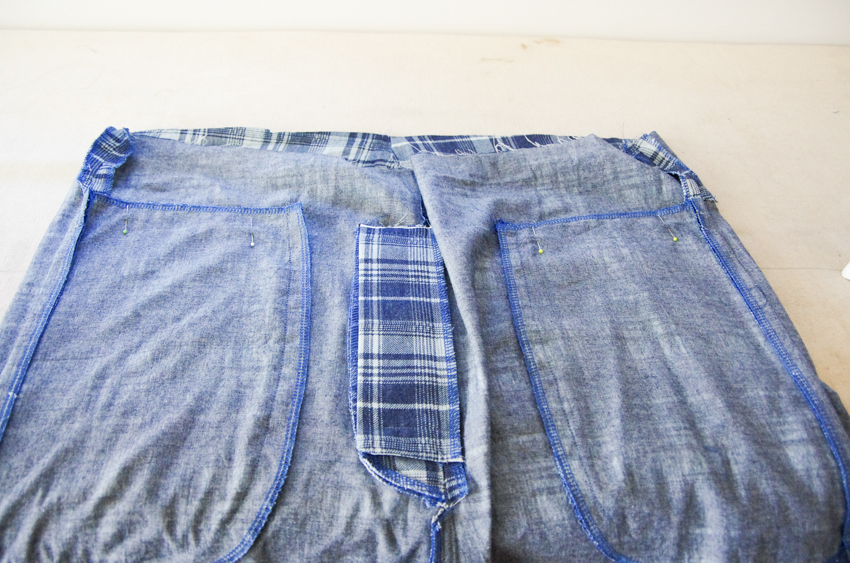
Turn the pjs inside out once again and pin the pockets in place along the top. Use a long basting stitch to sew them in place so they don't flap around in the next steps.

Finish your pockets by adding a bar tack at the top and bottom of the pocket opening on the front of the pajamas. This bartack will go through the pajama front and the pocket bags (not the pajama back). An attractive looking bartack can be made with a narrow zig zag with almost no length so that the stitching is very dense.

I was using my industrial machine for this project so I simply backstitched thoroughly since my machine only performs a straight stitch. No matter the stitch style, this will really help to increase the lifespan of your pjs if the wearer likes to put his hands or phone in his pockets.

Next, we proceed to the waistband and hemming which means we will be finishing our pajamas!
Eastwood Pajamas Sew-Along: Day 5 - Waistband and finishing details
Today is the last day of our Eastwood Pajamas sewing process! Time to tackle the waistband and the finishing details.

Let's begin by binding the raw edge of the waistband. You can use 1.5 m pre-made double fold binding if you like, or you can make your own! Regardless which option you choose, feel free to use any finished width you prefer working with. In the instruction booklet I explain how to make a narrow binding with a finished width of 3/8". To do this, begin by cutting a 1.5 m long strip of fabric measuring 1 1/4" wide - this doesn't need to be on the bias, I just tore along the grain to get a straight line.

Fold in each edge 1/4" and press. You can use a bias tape maker to make short work of this step if you like! I just pressed by hand.

Fold your strip more or less in half and press. I like one half to be larger than the other, this way, I can sew from the narrow side and be sure that I caught my wider side with stitching.

Beginning at center back, apply your binding to the waistband. I simply sandwich the waistband in the binding and then stitch with small adjustments as I go...I find pinning narrow binding to be too finicky and this way leads me to better results.

When you circle the waistband and arrive once again at center back, you'll need to trim the excess binding but leave yourself 1-2" of overlap.

To enclose the final raw edge, open up the binding and finger press the raw edge over. Close the binding once again and finish your stitching. The waistband is now tidily bound!

If you plan to add a drawstring, it is necessary to prepare the buttonholes before proceeding with sewing the waistband. Begin by placing a 2" X 2" scrap of interfacing over each buttonhole marking. Make sure the buttonhole markings are transferred in a visible manner. I refreshed my markings on top of the interfacing with pink chalk and stitched my buttonholes from the wrong side of the garment.

While completing the waistband buttonholes I also added the fly buttonhole that I forgot earlier. This is a nice time to add it if your buttonhole function is time consuming to set up...this way you can tackle all three buttonholes at once! As you can see in the photo above, I just pushed the other layers of the fly out of the way and added the buttonhole to the middle layer.

I usually stitch my buttonholes twice, use a Clover buttonhole chisel to open them, and then stitch them once again to enclose any fraying fabric or threads.
Now we move on to installing the elastic! If you are sewing Variation 1, use your favourite trick to insert the elastic into the casing - perhaps you have a certain tool you like to use (we have a number of them in our shop) or you like to attach a safety pin to your elastic so you can feel the ridge of metal through the fabric layers as you bunch your elastic along. Those sewing Variation 2 or 3 can follow along with what I do here:

Begin by turning the waistband under at the notch (2 1/4" from the fabric edge). Press. Sorry, I forgot to snap a photo of this step! The photo above is from a little later in the sewing process. It shows my PJs with the elastic added and pins in place...but you can still see what the folded over waistband looks like.

Cut your elastic to length using the provided chart or by wrapping it around the prospective wearer. If you are not following the chart, be sure to add 2" extra to your custom size for overlap! Overlap 2" as pictured above (on an elastic sample I made while developing the pattern) and stitch a square with an X through it to securely create a loop.

Insert the elastic between the waistband layers. Pin it in place as follows: First, divide the elastic in half and pin it in place at the center back and center front seam. Next, divide the elastic in quarters and pin it in place at the side seams - you can see I've just divided the elastic in quarters but have not yet inserted it at the side seam in the photo above.

Divide each pinned segment in half so the excess fabric is evenly distributed. Pin. You can see there is quite a lot of excess fabric!

From the right side of the pajamas, create the first stitching line 1 3/4" from the top of the waistband. This will be below your elastic and just above your binding. Don't stitch over the elastic during this step and make sure to pull the fabric taut as you stitch so as not to create puckers. To keep your elastic in place, keep your pins in if possible...if you can't without stitching over the heads, take them out as you go and re-pin before the next line of stitching.

Create the next row of stitching 1/4" up from the first line. This time, you will be stitching on the elastic. Stretch the fabric very taught (this will also stretch the elastic) as you sew. Above you can see how the fabric looks before I stretched it taut and below you can see how it should look once taut:
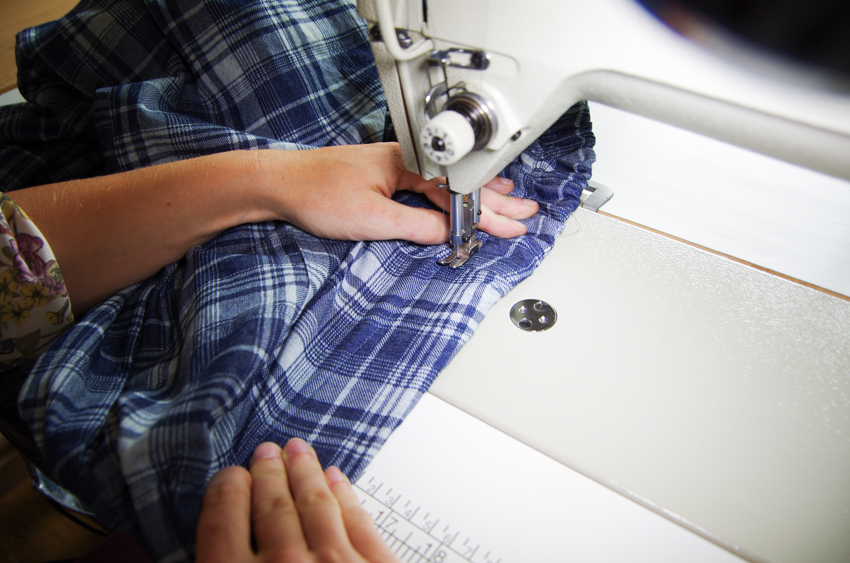

Add a third row of stitching 1/4" from the top of the waistband to completely secure the elastic.

If you aren't adding a drawstring, your waistband is now finished! To add a drawstring, begin by cutting 1.7m of twill tape, grosgrain or cording. I'm using a cotton grosgrain ribbon for my drawstring.

Finish the ends as suits your material - stitch or knot cottons and melt man-made materials to prevent fraying.

Insert the drawstring through one of the buttonholes using a safety pin clasped onto the end of the ribbon as something for you to feel for as you guide the ribbon through the casing.

Remove the fly and pocket basting, tie your drawstring in a bow and your PJs are beginning to look VERY close to finished!

Hem the PJs by folding up the raw edge 3/8". Press.

Fold up again, this time using the hem notch as a guide (your finished hem will be just over an inch wide). Edgestitch the hem and then topstitch 1/4" away from your first line of stitching.

If you've left your handstitching until last (as I am wont to do), now is the time to add your fly button! Add it to the innermost layer of the fly to correspond with the buttonhole.

And there we go! Our Eastwood Pajamas are finished!


I hope you enjoyed this sewing process! Thanks for joining me.
Eastwood Pajamas Sew-along: Day 6 - The Parade
A few of you who sewed along with me have submitted your finished Eastwood Pajamas for today's parade...and there is a definite theme going on: Linen and shorts for summer!

Nick sewed these striped linen pajamas with cotton cording. What a perfect color match he managed with that cording! He reports (by email) that next time he sews with this style of linen he will try out french seams since the linen frays so much. This would be a lovely way to finish the inseams and side seams when sewing with very light weight fabrics. Heavier fabrics could benefit from bound seam allowances if you have the patience!
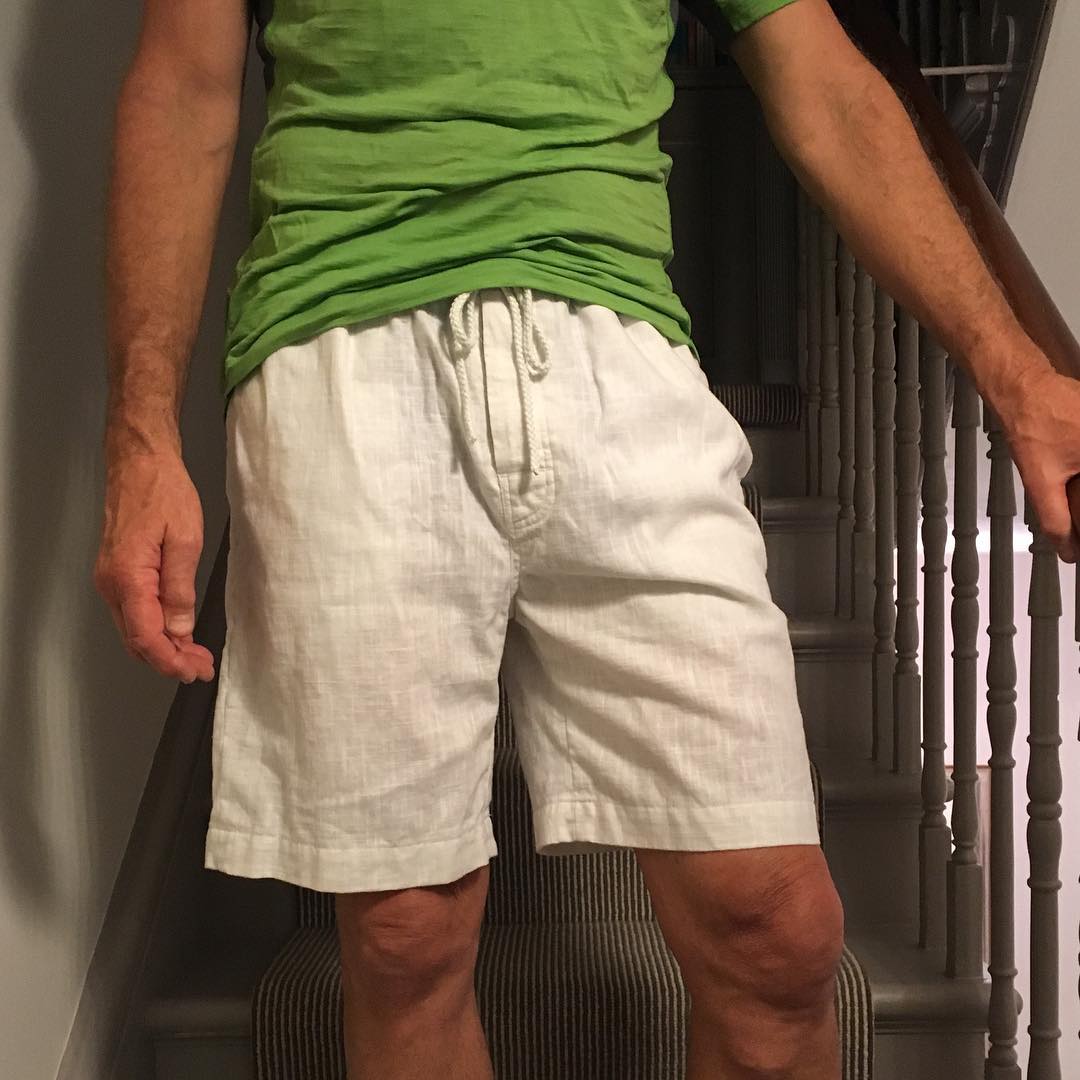
Liz sewed this pair of white linen Eastwood shorts for her husband and reports that her son is now waiting for her to sew some for him! It looks like she did a lovely job of that fly topstitching.

Lastly, Susanne was able to use up a small scrap of Dr. Who fabric that she treasured to make her son some tardis boxers! They used only 34" of a narrow 45" fabric that she found on Spoonflower. She reports that she made a size medium and cut a 6" inseam plus hem allowance.
These three busy sewists will be receiving our upcoming pattern release for free as a thank you for sewing along with me these last couple of weeks!
Comox Trunks Sew-Along: Day 1 - Schedule
Welcome to the Comox Trunks Sew-Along. Each post will only involve about half an hour of sewing which makes this a great sew-along to follow if you are fairly new to sewing and a little overwhelmed or if you have a really busy schedule.
- April 4th: Choosing your fabric and elastic
- April 6th: Picking a size and ideas for customizing (lengthen the legs, enlarge the front cup, create narrower legs, or remove the right exit fly)
- April 8th: Cutting out your fabric and preparing your machine
- April 10th: Sewing the trunks front
- April 12th: Sewing the trunks back
- April 14th: Hemming the trunks
- April 16th: Attaching the elastic waistband (or adding a fabric covered waistband) – We’re done!
Comox Trunks Sew-Along: Day 2 - Picking a size and ideas for customizing
Welcome to Day 2 of the Comox Trunks sew-along!
Do you have your fabric picked out? You still have time to pre-wash it as we won’t be cutting out the pieces until Tuesday, April 8th.
Today we are choosing a size and later in the post I will show you some ideas I and a few other sewers have had regarding how to customize your trunks for the perfect fit and style.
First off, when choosing your size, it is important to realize that it is largely the elastic waistband that determines the fit of the trunks. Everyone has slightly different proportions to their waist, hips and butt and they may also have preferences to how tight or loose they like elastic waistbands to be (underwear are a very personal thing!). Also, there are many types of elastic which have different amounts of stretch to them. If the elastic you choose stretches more or less than our sample elastic did, you will end up with a different fit than we did!
I recommend using our body measurement guide to choose the size for the fabric portion of the trunks as you normally would for a sewing pattern but then wrap the elastic directly around the wearer to choose the length of your elastic. We have provided guideline measurements for the elastic in our “Materials Required” chart in case you prefer to use our estimates (if the trunks are a gift, for example), but otherwise, this is how you figure out how much elastic you will need:
1. Take a length of elastic and wrap it around the wearer’s upper hips (where their boxer elastic normally sits) making sure to wrap it as tight as they would like it to be when they wear the boxers. The elastic should have to stretch very slightly so that their trunks stay up!
2. Mark this length and then add 3/4″ to the length for your seam allowance (two seam allowances of 3/8″).
3. Compare your resulting measurement with our elastic measurements in the “Materials Required” chart. They should match ours or be fairly close. When you sew your trunks, you may have to ease or stretch the top edge of the trunks slightly when attaching them to the waistband. Don’t worry if this results in a few ripples – one the wearer puts them on they will stretch out to perfectly suit their body (due to their custom-fit elastic waistband!).
Now that we’ve determined the amount of elastic we need, here are a couple tips about choosing a size.
1. The trunks are drafted with negative ease. This means they are smaller than the wearer’s body so that they fit like a second skin. For our plus-sizes though (size 39-45) we have graded the pattern differently so that the wearer has more room in their trunks (the grading is larger and the sizes expand wider than the other sizes).
2. Our waist measurements correspond to the wearer’s natural waist. This is approximately at naval level and is NOT where the trunks will end up sitting (those would be some high-rise trunks!).
That’s it! Now lets move on to some ideas for customizing the fit and style. I have four different ideas and would also love to hear your suggestions (leave a comment below with tips and questions!).
Idea #1: Lengthen the legs: Some people may feel a little under-dressed in such tight fitting skimpy little trunks :P That’s an easy fix – simply lengthen the legs for a more conservative pair of shorts! Here is how you do this:

 Idea #2: Enlarge the front cup: Are you sewing for someone who is generously endowed? Our trunks have what I would describe as a “solid medium” size cup. You can very simply enlarge (or decrease) the size of the cup by altering the curve of the front pieces as follows:
Idea #2: Enlarge the front cup: Are you sewing for someone who is generously endowed? Our trunks have what I would describe as a “solid medium” size cup. You can very simply enlarge (or decrease) the size of the cup by altering the curve of the front pieces as follows:

Idea #3: Create narrower legs: Does your wearer have skinny legs? They may be comfortable with the extra room in the legs (after all, no one wants to feel constricted by their undies) but if they would like the second-skin fit that these trunks are designed to have, you can adjust the pattern piece as follows (note that this must be done to the paper pattern rather than the fabric since these trunks don’t have a side seam!):
 Idea #4: Remove the “right exit fly”: This is my favourite idea and is one that has generated some very hilarious discussions at our latest family gathering. I gave my brother-in-law a pair of Comox Trunks for his birthday at a large dinner party. Quickly one of the female dinner guests commented, “Does anyone actually use those tiny little front openings???” I must say that I didn’t really have an answer! We included them as part of the design because they are so commonly found on modern underwear and I didn’t want our design to lack something that ready-to-wear clothing normally has. Fortunately, my brother-in-law had a very confident answer: When in dress uniform/fancy attire (at his job, for example) his shirt has been very carefully ironed and tucked in. In a scenario such as this he, with out a doubt, goes “through the gate.” In casual uniform/regular clothes he is not constricted by his tucked in shirt and most certainly goes “over the fence.” HAHA! As you can imagine, his knowledgeable explanation of the matter, complete with specialized metaphors, gave us quite a laugh :).
Idea #4: Remove the “right exit fly”: This is my favourite idea and is one that has generated some very hilarious discussions at our latest family gathering. I gave my brother-in-law a pair of Comox Trunks for his birthday at a large dinner party. Quickly one of the female dinner guests commented, “Does anyone actually use those tiny little front openings???” I must say that I didn’t really have an answer! We included them as part of the design because they are so commonly found on modern underwear and I didn’t want our design to lack something that ready-to-wear clothing normally has. Fortunately, my brother-in-law had a very confident answer: When in dress uniform/fancy attire (at his job, for example) his shirt has been very carefully ironed and tucked in. In a scenario such as this he, with out a doubt, goes “through the gate.” In casual uniform/regular clothes he is not constricted by his tucked in shirt and most certainly goes “over the fence.” HAHA! As you can imagine, his knowledgeable explanation of the matter, complete with specialized metaphors, gave us quite a laugh :).
If you see no reason to go “through the gate”, you can save yourself some sewing time by removing the bound entry. Simply adjust the sewing process as follows to create a completely closed front cup (I still recommend keeping it double layered so that the shorts provide nice coverage and are hard-wearing):

Do you have any other ideas to alter the design or fit of the trunks? It’s fun brainstorming these sorts of things for a pattern that isn’t very common. At first examination the design, with it’s unusual seams and close fit, seems quite un-alterable but hopefully you now realize that this is not the case! The Comox Trunks can be altered to create all sorts of menswear underwear styles and can be made to suit the many individual requirements men have for their undies.
Comox Trunks Sew-Along: Day 3: Choosing Your Fabric and Elastic
Welcome to the first day of our Comox Trunks Sew-Along! Today I will be giving you some tips and a photo guide to choosing your fabric and elastic. Here are the supplies I have gathered together to sew up some Comox Trunks:
As you can see, the fabric I have chosen is a lightweight charcoal coloured knit. It is comprised of bamboo and cotton with a touch of spandex. It is available as part of our Comox Trunks Supplies Kit along with the black elastic.
If your local haberdashery only has a small selection of knit fabrics, don't worry, you still likely be able to find something that will work for your Comox Trunks. The Comox Trunks will end up fitting best throughout a long day of wear if you pick a fabric with at least a small amount of spandex content. The spandex adds resiliency to the fabric to help prevent your trunks from growing baggier and saggier throughout the day.
Here is a close up examination of the bamboo/cotton jersey that we include in our Comox Trunk kits. It is deliciously soft and thinner than most t-shirt style knits. It is strong though and has just enough spandex content that it works perfectly for the trunks:

While it might be difficult to find a bamboo blend knit in your local fabric store, most fabric stores have at least one or two bolts of t-shirt style knits. These are medium weight knits that usually have a high cotton content. Here is an example of this (a medium weight striped t-shirt knit comprised of 95% cotton and 5% spandex):

A more stable (and thus easier to sew!) form of the t-shirt knit is also commonly found in fabric stores. The one I found is this red "Sport n Play" actionwear T-knit Jersey which is comprised of 90% cotton and 10% spandex. This is a great choice for people who are new to knits because it has a lot of stretch (so your tight fitting garment will stay tight fitting) but is also thick enough and tightly knit enough that it won't warp and become misshapen while you sew:
 Lastly, as you saw in the photos of the prize pack that I showed the other day, I picked up a novelty Canadian maple leaf knit which was simply labelled "mixed fibres." It doesn't have as much elasticity as the other fabrics but has still worked well for the trunks:
Lastly, as you saw in the photos of the prize pack that I showed the other day, I picked up a novelty Canadian maple leaf knit which was simply labelled "mixed fibres." It doesn't have as much elasticity as the other fabrics but has still worked well for the trunks:

Since the trunks only need a small piece of fabric and a short amount of time to sew, if you are in doubt about your fabric choice, why not try out a few types so that you will become more confident with sewing knits in the future (armed with your Comox Trunks sewing knowledge, you'll be eager to start sewing all sorts of comfy knit sweaters and dresses!!!)
To figure out if your prospective fabric has enough elasticity, use the handy knit guide in the instruction booklet (and also on the back of the envelope if you purchased the tissue version of the pattern).

To use this guide while standing beside the bolt of fabric in the store, lay down the guide on a table (or have someone hold it for you) and unroll a length of fabric to work with.
Since the Comox Trunks require a material that stretches in all directions (in other words, a fabric with 4-way stretch), you can test either the length or width of the fabric first. Just remember to test the other direction after!
Hold a 3" length of fabric up to the black bar and mark and keep the left hand (which is pinching the fabric) stable and still at the edge of the bar.
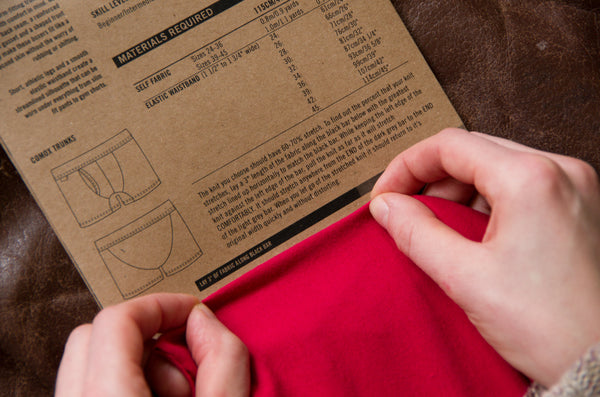
Stretch your right hand and the fabric to the right until the fabric has stretched as far as it easily wants to go (don't use all your strength, you will be able to tell how far it naturally wants to stretch). If your right hand and the pinched end of the 3" chunk of fabric are now within the lightest grey section of the bar, the fabric you have chosen has enough stretch to be made into Comox Trunks!
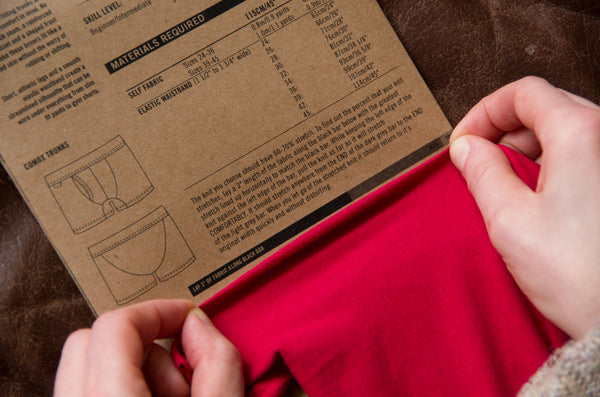
One last thing you want to check is how quickly and completely it 'bounces' back to its original position. If your fabric looks stretched out or warped when you release your right hand then it does not have enough spandex content and resiliency to maintain its shape once made into the trunks.

Now that we've found a suitable fabric, its time to move on to choosing an elastic!
The elastic I am using (the same elastic that is included in the kits) is firm without being scratchy. It is not soft on one side as some ready-to-wear underwear elastics are (both sides are the same texture on this elastic) but it is very strong and will likely survive many washes before it begins to ripple. If you are sewing these trunks for someone with extremely sensitive skin we will be covering how to create a soft fabric casing for the elastic later on in the sew-along!

While the pattern calls for 2" elastic, it is perfectly acceptable to choose something wider or narrower. I like the look of the 2" band and Matt thinks that this width produces the comfiest results (narrower elastics can sometimes create the feeling of a little more pressure against the skin). It is very common to see trunks with 1" to 1/2" elastic bands so go ahead and save a bit of money by choosing a narrower elastic if you desire!
The plush elastic that I picked for the sew-along prize pack is 1 1/2" wide and is quite thick. It is very soft on both sides. Here you can see how the two types compare:
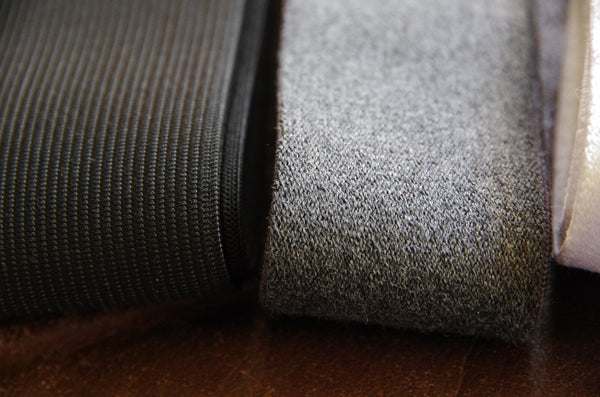
While you're at the fabric store, don't forget to pick up a needle suitable for sewing knits. You can sew the entire project using a ball point needle or stretch needle. If you like using a twin needle, you can buy one of those for the hem and for attaching the elastic waistband. These are the ball point needles that I use:

Have any questions about what supplies you will need? If you are hesitating over a fabric or elastic choice, I would love to give you my opinion - just leave a comment or send us an email (info@threadtheory.ca)! Join us again in two days to pick a pattern size and to contemplate any customisation you might like to do!
Comox Trunks Sew-Along: Day 4 - Cutting out your fabric and preparing your machine
It is officially Day 3 of the Comox Trunks sew-along and today we are finally going to start working with our fabric! Today we will be cutting out our fabric and preparing our sewing machines to work smoothly with thin knits. By now you should have gathered together your pre-washed knit fabric, corresponding thread, a length of medium weight pre-shrunk knitted elastic (elastics will normally specify on the roll/packaging whether they have been pre-shrunk or not...if they aren't it is advisable to wash them with your fabric as that's what you'll be doing when the trunks are finished, after all!). You should also have picked your size.
If you have not yet chosen your materials, have a look at the fabrics and elastics I suggest throughout this post.
Okay, let's begin! Lay out your pre-washed fabric by folding it in half and matching up the selvages. I like to pin the selvages together, especially with knits that are prone to curling, so as to ensure that all the pattern pieces will be properly lined up with the grain of the fabric. See how the knit likes to curl?

In the first edition of our printed instruction booklets, I have made fabric layouts that specify you should cut pattern piece 2 and 3 on a single layer of fabric. We've since revised these layouts so that this is no longer necessary - simply cut them on the folded fabric along with all the other pieces so as to create two 'mirrored' versions of each piece.
The only pattern piece that needs to be cut 'on the fold' is piece 4 which is the back of the trunks. Cutting this on the fold will result in a single fabric piece that is double the width of the paper pattern piece.
Also, if you are using a fabric with 4 way stretch which is a recommended fabric choice for these trunks (this means that the fabric stretches length-wise and width-wise), you don't necessarily need to cut piece 6 (the binding) on the bias. We placed the grainline in this manner so that you have the option to use contrast colours or prints for your binding regardless of if they are 4-way or-2 way stretch (or even a woven fabric if you are feeling adventurous!).
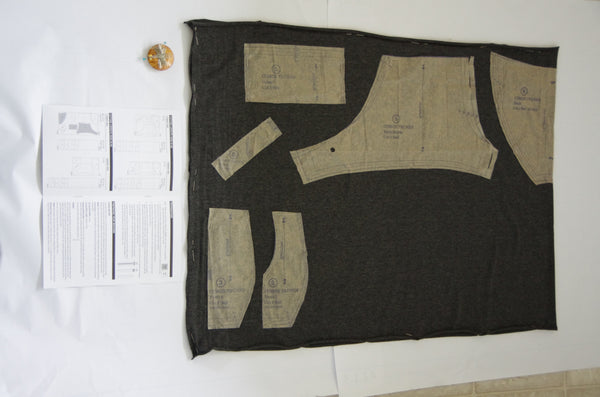
When cutting out your fabric, mark notches by clipping triangles outwards our using chalk or a pin. Avoid clipping into the seam allowance partly because it is quite small (only 3/8") but mostly because some knits have a tendency to run when nicked (even after you've sewn the seam).
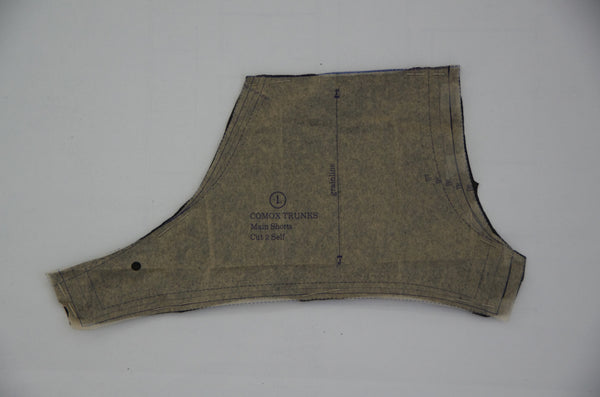
Here's a close up of the little notch I made:

Now that all of our pieces are cut out, its time to set up the machine!
For this sew-along I am sewing one pair of trunks with my regular domestic machine:

...And a second pair of trunks using my serger:

This way, you will be able to see how to construct your trunks with any available machine. It is well worth your while to play around with the settings on your machine with a scrap of your fabric until the machine works smoothly and your stitches are even. My little domestic doesn't have a huge amount of stitch options but I find the zig-zag stitch works well for the main seams with a narrow width. Also, it really helps to adjust the presser foot pressure so it is lighter than normal.
Also, I like to use a ball point or stretch needle when using knits. After all of our careful cutting of outward notches it would be a shame to cause a run in the fabric because the sharp needle has snapped some of the fibres!

This next picture is not very clear but hopefully you can see how I played around with adjusting the width of the zig-zag stitch. After creating a seam of varied zig-zag widths using two layers or knit I pulled open the layers to examine which width of zig-zag was the most invisible from the right side. If your stitch is too wide you will see threads and ripples on the right side of the garment - not good!

Here are the settings that I found worked best on the charcoal jersey for my machine (remember that the number scale and settings are different on every machine so don't be tempted to blindly use my numbers....test test test on your scraps!):
When I use the reinforced straight stitch for seams that need lots of strength (this works well on some knits but it is too rough on delicate knits and can cause holes because the needle punches the same area three times):
When I use the zig-zag stitch for major seams:


I didn't take photos of my serger's settings because it turned out that the stitches looked best on the Maple Leaf fabric that I used for my serged sample when I set the Differential Feed to "0". You might notice in the instruction booklet that I mention you should adjust the Differential Feed when sewing knits. I think this wasn't necessary for the Maple Leaf knit because it has very little stretch and acted more like a woven.
If you are confused about what I mean by Differential Feed, you need look no farther than this excellent blog explanation to have this dial de-mystified!
Are you raring to get sewing yet? We'll get started on Thursday by sewing the trunk front which is the most fiddly bit of this really fast project. Looking forward to it!







